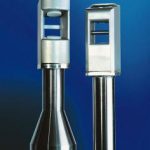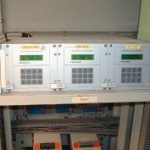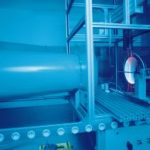As site operator on the Hoechst Industrial Park, Infraserv Hoechst provides a broad spectrum of services to the businesses established there. One important task is the continuous monitoring of volume flow of waste gas partial flows in a thermal waste gas purification plant, which is regularly monitored by the Infraserv Hoechst independent measuring point using a reference measuring method. The economic solution to the continuous monitoring of volume flow has been provided with the help of vortex equipment.
Modern manufacturers in process engi-neering concerns must adapt quickly to the manufacturing of new products. This applies in particular to the pharmaceutical sector. With this in mind, the treatment of the varying compositions of emissions arising is of great significance. The thermal oxidation of the hydrocarbons, and more or less large parts of organic matter such as N, Br, S and Cl compounds with which emissions are charged, is to be carefully monitored and documented. Dust charging in particular gave rise to big problems with the previously used differential pressure gauges.
Vortex more economical than differential pressure
The vortex measuring system presents itself as an alternative to the differential pressure gauges. An example of this is the Aventis Pharma Deutschland GmbH thermal waste gas purification plant at Hoechst, a concern of the Sanofi-Aventis Group. Even in 1998 Aventis planned the vortex measuring points which were installed one year later in the waste gas pipe before feeding the thermal waste gas purification equipment. This system, which is connected to the waste gas source of the production via pipelines, has been in operation since 1999 using these sensors.
The vortex sensors are used both in steel tubes and glass fibre reinforced plastic tubing of 300 to 450 mm inside diameter at approx. 30 hPa static pressure. The temperature of the waste gas flows lies at 30 to 32 °C with a flow velocity of 3 to 5 m/s and Ex-Zone 0 classification.
Measuring of the waste gas volume flow at Aventis Pharma on the Hoechst Industrial Park is carried out for two reasons:
- Firstly for quantity acquisition, to determine the identification suitable for the allocation of the waste gas to be purified and then to carry out the cost calculation.
- The second reason is the safety of the installation. The explosion hazard is to be dealt with reliably: explosive mixtures are sucked out of the system, to prevent the possibility of explosion. The relevant quantities are to be recorded and documented.
High measuring certainty
Burkard Maniura, Infraserv Hoechst’s deputy director for testing under specifications defined in §26/28 BImSchV (German Air Pollution Law), is more than satisfied with the Höntzsch vortex sensors: ”According to reports from Aventis, the Höntzsch sensors installed in 1999 function with absolute reliability. No repairs whatsoever have been necessary and the preventive maintenance is limited to quarterly inspections of the sensors for any possible caking of dust by the operator. After the maintenance-intense experiences with the differential pressure gauges we wanted to be sure that the unusually long endurance attributed to the vortex measuring systems, would yield the correct values. Therefore, after the first year of operation we checked the vortex measuring results using a different measuring system, the vane wheel sensors, also manufactured by Höntzsch. The results were as good as corresponding. The measuring points are running well and endurance is very good.”
Robust sensory mechanism
In the end it was the indifference to dust which was the decisive factor for using vortex sensors. At Aventis Pharma measuring probes of the series VA 40/20 ZG 6 are in use. This series of fixed length probes is intended for insertion in pipelines of 80 mm inside diameter and for nominal diameters of up to 3000 mm inside diameter. The measuring position is determined by pipe inside diameter, sensor length and single ended flange nipple length. For application in industrial capacity furnaces extendable probes are available for virtually any diameter. The vortex flow sensors have no moving parts. They are TÜV qualification tested for the continuous measurement of waste gas volume flow in incineration plants requiring official air pollution authorization by TA Air (German Clean Air Act) and specifications defined in 13th and 17th BImSchV. Within the framework of the respective sensor specifications, measurement is not dependent on density, pressure and temperature. Gases, which have been contaminated by solids, do not influence the measured values in any way, as long as caking or abrasion does not occur. The flow is also correctly registered with a gas compound which changes over time. Compared with the vane wheel flow sensors, the vortex sensors show distinct endurance advantages in these harsh measuring conditions. The horizontal positioning of the sensors allows any potential condensates in the measuring gas to drop off, so that even moisture in the gas hardly affects the measurement accuracy. For applications where a heavy build-up of condensates is permanent Höntzsch can supply a special signal-processing module, which prevents measuring errors. The length of cable between sensor and electronics can be up to 400 m.
Special probe guide pieces facilitate problem-free insertion and extraction of the probes in pipelines or ducts without interrupting the process. The sealing mechanism is adapted to the relevant temperature and pressure conditions in the pipeline.
With vortex sensors the measuring uncertainty in velocity measurements lies below 10 m/s at ±0.15 m/s of the measured value; above 10 m/s when ±1.5 % of the measured value is specified. Thanks to the exceptional calibration technique the vortex sensors are so calibrated, that deviations in flow velocities of up to 40 m/s are no greater than ±0.15 m/s.
For Ex-protection
The VA 40 vortex sensors are test certified according to Atex design and correspond to EEx ia IIC T6 type of protection. The intrinsically safe isolation/supply unit LDX1A Atex converts the flow velocity frequency-proportional signal of an Ex-vortex flow sensor to a conductively decoupled signal for the transducer or evaluation unit. For measuring volume flow or flow velocity Höntzsch uses microprocessor-controlled transducers of the U2a series. These transducers supply a 4…20 mA analog signal. Also available on request: 0 to 20 mA, 0 to 4 V or 0 to 10 V.
The sales programme also includes instruments with display and keypad, which can be supplied with almost unlimited options to suit the needs of measuring technology engineers.
Hall 7, Booth A15
cpp 438
Vortex Flow Sensors VA
Hoechst Industrial Park
Share:









